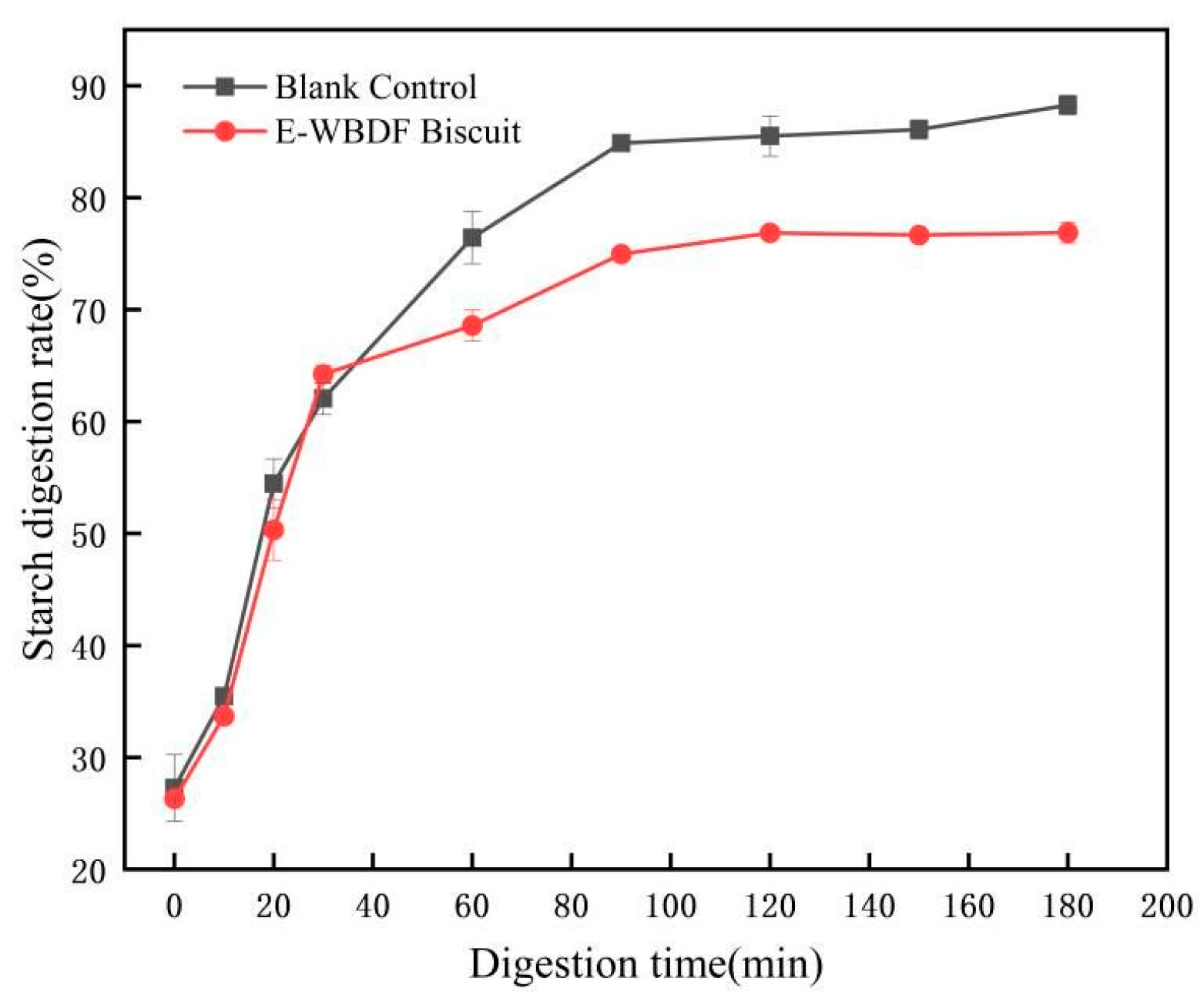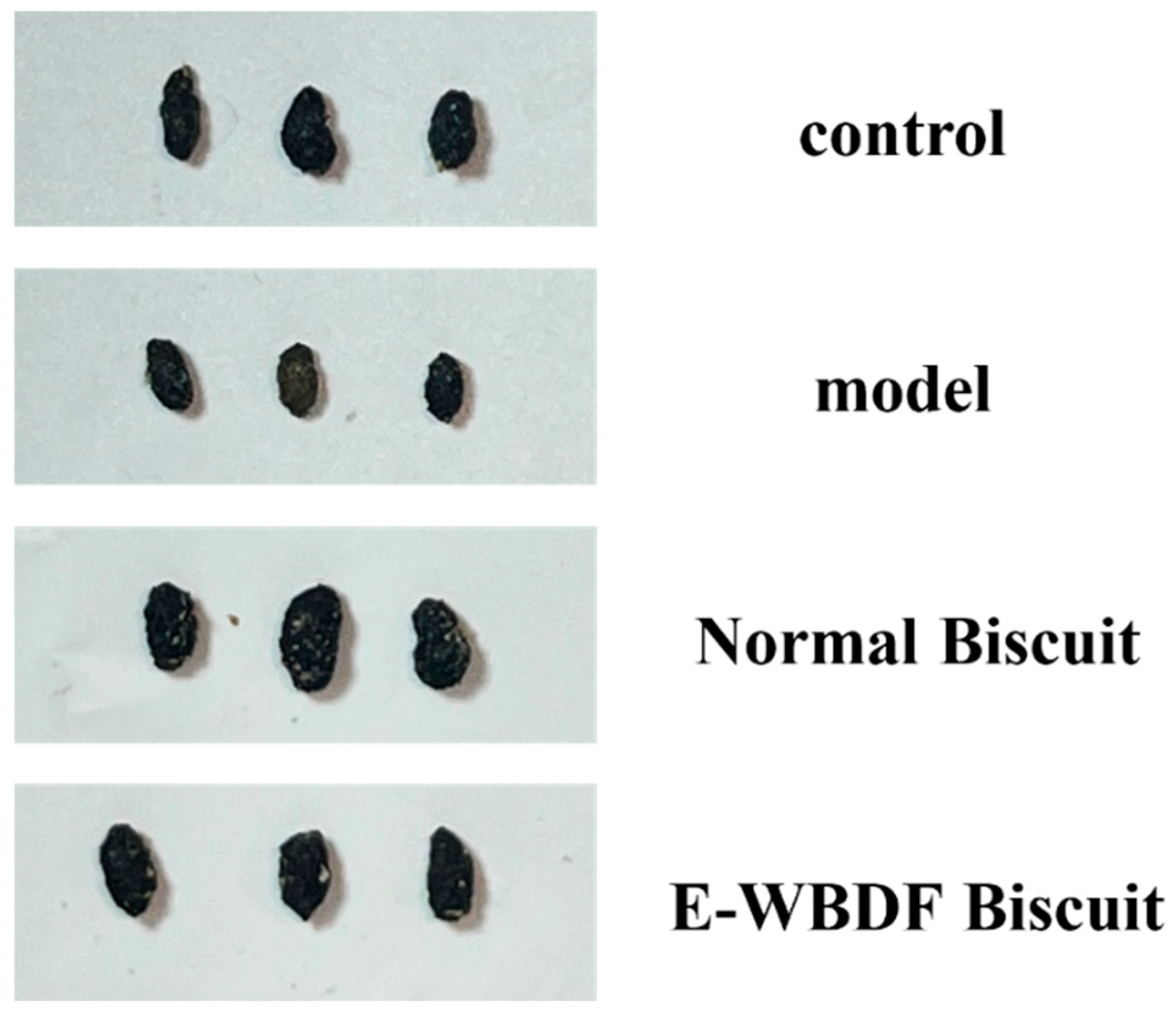Preparation and Digestive Properties of Biscuits Enriched with Extrusion-Modified Dietary Fiber: Effects on Slow Transit Constipation
Abstract
1. Introduction
2. Materials and Methods
2.1. Materials and Reagents
2.2. Biscuit Preparation
2.3. Texture Measurement
2.4. Color Measurement
2.5. In Vitro Digestion of Biscuits
2.6. Experimental Animal Models and Treatments
2.6.1. Modeling of Slow Transit Constipation
2.6.2. Mouse Defecation Experiment
2.6.3. Propulsion Rate Determination in the Intestines
2.7. Statistical Analysis
3. Results
3.1. Biscuit Texture Analysis
3.2. Biscuit Color Analysis
3.3. Biscuit Digestibility Characteristic Analysis
3.4. Animal Experiments
3.4.1. Effects of Normal Biscuit and E-WBDF Biscuit on Defecation in Mice
3.4.2. Effect of Normal Biscuit and E-WBDF on the Propulsion Rate of the Small Intestines in Mice
4. Discussion
5. Conclusions
Author Contributions
Funding
Institutional Review Board Statement
Informed Consent Statement
Data Availability Statement
Conflicts of Interest
Abbreviations
| DF | Dietary fiber |
| E-WBDF | Extrusion-modified wheat bran dietary fiber |
| WB | Wheat bran |
References
- Anderson, J.W.; Baird, P.; Davis, R.H.; Ferreri, S.; Knudtson, M.; Koraym, A.; Waters, V.; Williams, C.L. Health benefits of dietary fiber. Nutr. Rev. 2009, 67, 188–205. [Google Scholar] [CrossRef] [PubMed]
- Cheng, W.; Sun, Y.J.; Fan, M.C.; Li, Y.; Wang, L.; Qian, H. Wheat bran, as the resource of dietary fiber: A review. Crit. Rev. Food Sci. Nutr. 2022, 62, 7269–7281. [Google Scholar] [CrossRef] [PubMed]
- Ma, S.; Wang, Z.; Liu, H.M.; Li, L.; Zheng, X.; Tian, X.; Sun, B.; Wang, X. Supplementation of wheat flour products with wheat bran dietary fiber: Purpose, mechanisms, and challenges. Trends Food Sci. Technol. 2022, 123, 281–289. [Google Scholar] [CrossRef]
- Saini, P.; Islam, M.; Das, R.; Shekhar, S.; Sinha, A.S.K.; Prasad, K. Wheat bran as potential source of dietary fiber: Prospects and challenges. J. Food Compos. Anal. 2023, 116, 105030. [Google Scholar] [CrossRef]
- Onipe, O.O.; Ramashia, S.E.; Jideani, A.I.O. Wheat bran modifications for enhanced nutrition and functionality in selected food products. Molecules 2021, 26, 3918. [Google Scholar] [CrossRef]
- Li, R.R.; Wang, C.Y.; Wang, Y.; Xie, X.; Sui, W.; Liu, R.; Wu, T.; Zhang, M. Extrusion modification of wheat bran and its effects on structural and rheological properties of wheat flour dough. Foods 2023, 12, 1813. [Google Scholar] [CrossRef]
- Dang, T.T.; Vasanthan, T. Modification of rice bran dietary fiber concentrates using enzyme and extrusion cooking. Food Hydrocoll. 2019, 89, 773–782. [Google Scholar] [CrossRef]
- Arepally, D.; Reddy, R.S.; Goswami, T.K.; Datta, A.K. Biscuit baking: A review. LWT Food Sci. Technol. 2020, 131, 109726. [Google Scholar] [CrossRef]
- Aboshora, W.; Yu, J.H.; Omar, K.A.; Li, Y.; Hassanin, H.A.M.; Navicha, W.B.; Zhang, L. Preparation of Doum fruit (Hyphaene thebaica) dietary fiber supplemented biscuits: Influence on dough characteristics, biscuits quality, nutritional profile and antioxidant properties. J. Food Sci. Technol. 2019, 56, 1328–1336. [Google Scholar] [CrossRef]
- Ma, F.Y.; Lee, Y.Y.; Palmquist, D.E.; Baik, B.K. Bran characteristics influence the quality of whole-wheat pancakes and baking powder biscuits. Cereal Chem. 2019, 96, 634–646. [Google Scholar] [CrossRef]
- Sozer, N.; Cicerelli, L.; Heiniö, R.L.; Poutanen, K. Effect of wheat bran addition on in vitro starch digestibility, physico-mechanical and sensory properties of biscuits. J. Cereal Sci. 2014, 60, 105–113. [Google Scholar] [CrossRef]
- Wang, Z.; Tan, D.; Zhao, K.; Shen, W.; Jia, X.; Liu, B. Physicochemical and functional properties of extruded wheat bran dietary fiber: Effects on slow transit constipation. Ital. J. Food Sci. 2025, 37, 421–431. [Google Scholar] [CrossRef]
- Wu, F.; Tian, F.L.; Jin, Z.; Liu, J.; Jin, W.; Chen, X.; Wang, Z.; Jia, X.; Liu, B.; Liu, L.; et al. Antioxidant capacities of heat-treated wheat germ and extruded compounded bran. Cereal Chem. 2022, 99, 582–592. [Google Scholar] [CrossRef]
- Zhang, S.J.; Jia, X.W.; Xu, L.N.; Xue, Y.; Pan, Q.; Shen, W.; Wang, Z. Effect of extrusion and semi-solid enzymatic hydrolysis modifications on the quality of wheat bran and steamed bread containing bran. J. Cereal Sci. 2022, 108, 103577. [Google Scholar] [CrossRef]
- Xiong, S.Q.; Li, Y.X.; Chen, G.; Zou, H.; Yu, Q.; Si, J.; Yang, H. Incorporation of Huangjing flour into cookies improves the physicochemical properties and in vitro starch digestibility. LWT Food Sci. Technol. 2023, 184, 115009. [Google Scholar] [CrossRef]
- Baumgartner, B.; Özkaya, B.; Saka, I.; Özkaya, H. Functional and physical properties of cookies enriched with dephytinized oat bran. J. Cereal Sci. 2018, 80, 24–30. [Google Scholar] [CrossRef]
- Gruppi, A.; Giuberti, G.; Duserm Garrido, G.D.; Spigno, G. Effect of different fibre addition on cookie dough and texture. Food Sci. Technol. Int. 2024, 30, 614–622. [Google Scholar] [CrossRef]
- Ayoub, W.S.; Zahoor, I.; Dar, A.H.; Anjum, N.; Pandiselvam, R.; Farooq, S.; Rusu, A.V.; Rocha, J.M.; Trif, M.; Jeevarathinam, G. Effect of incorporation of wheat bran, rice bran and banana peel powder on the mesostructure and physicochemical characteristics of biscuits. Front. Nutr. 2022, 9, 1016717. [Google Scholar] [CrossRef]
- Zhou, Z.J.; Ye, F.Y.; Lei, L.; Zhou, S.; Zhao, G. Fabricating low glycaemic index foods: Enlightened by the impacts of soluble dietary fibre on starch digestibility. Trends Food Sci. Technol. 2022, 122, 110–122. [Google Scholar] [CrossRef]
- Liu, M.Z.; Yan, K.; Yu, S.; Tan, F.; Hu, W.; Dai, Z.; Tie, H.; Zeng, X. Ganoderma lucidum driven fermentation of Rosa roxburghii pomace: Effects on noodle physicochemical properties, digestion, and gut microbiota. Food Chem. X 2024, 24, 102014. [Google Scholar] [CrossRef]
- Ranasinghe, M.; Alghaithi, M.; Stathopoulos, C.; Sundarakani, B.; Maqsood, S. Valorizing date seeds through ultrasonication to enhance quality attributes of dough and biscuit: Part 2—Study on bioactive properties, sensory acceptance, in vitro gastrointestinal digestion and shelf life of biscuits. Ultrason. Sonochem. 2025, 112, 107160. [Google Scholar] [CrossRef] [PubMed]
- Zhang, H.H.; Zu, Q.X.; Zhang, J.C.; Liu, S.; Zhang, G.; Chang, X.; Li, X. Soluble dietary fiber of hawthorn relieves constipation induced by loperamide hydrochloride by improving intestinal flora and inflammation, thereby regulating the aquaporin ion pathway in mice. Foods 2024, 13, 2220. [Google Scholar] [CrossRef]
- Zhu, S.Y.; Yan, M.; Feng, Y.J.; Yin, J.; Jiang, S.; Guan, Y.; Gao, B. Extraction of soluble dietary fiber from sunflower receptacles (Helianthus annuus L.) and its alleviating effect on constipation in mice. Nutrients 2024, 16, 3650. [Google Scholar] [CrossRef]
- Xu, L.; Qiu, B.; Ba, F.; Zhang, S.; Han, S.; Chen, H.; Wu, Y.; Gao, W.; Xie, S.; Chen, Y.; et al. Synergistic effects of Ligilactobacillus salivarius Li01 and psyllium husk prevent mice from developing loperamide-induced constipation. Food Funct. 2024, 15, 11934–11948. [Google Scholar] [CrossRef]
- Wu, L.; Tang, C.H.; Chen, L.L.; Zhao, J. Modified dietary fiber from soybean dregs by fermentation alleviated constipation in mice. Food Chem. X 2023, 19, 100810. [Google Scholar] [CrossRef]



| Sample | Hardness/gf | Elasticity/gf | Chewiness/gf |
|---|---|---|---|
| Normal biscuit | 4507.19 ± 318.33 a | 0.49 ± 0.03 a | 2365.22 ± 263.07 a |
| E-WBDF biscuit | 5781.17 ± 227.87 b | 0.62 ± 0.04 b | 4078.43 ± 362.72 b |
| Sample | L* | a* | b* | ΔE |
|---|---|---|---|---|
| Normal biscuit | 76.83 ± 2.41 a | 4.84 ± 1.78 b | 27.14 ± 1.72 a | - |
| E-WBDF biscuit | 67.21 ± 3.19 b | 6.87 ± 1.89 a | 29.40 ± 1.35 a | 10.09 ± 2.45 |
| Group | Time to First Evacuation of Black Feces/min | Number of Feces in 6 h/ | Quantification of Fecal Output in 6 h/g | Fecal Water Content/% |
|---|---|---|---|---|
| Control | 146.25 ± 2.86 c | 23.26 ± 4.19 a | 0.38 ± 0.03 a | 38.09 ± 2.56 a |
| Model | 212.50 ± 11.06 a | 9.33 ± 3.62 c | 0.15 ± 0.02 c | 27.06 ± 2.33 c |
| Normal biscuits | 178.33 ± 9.10 b | 13.33 ± 3.36 b | 0.20 ± 0.07 b | 32.85 ± 2.87 b |
| E-WBDF biscuits | 146.80 ± 11.30 c | 12.80 ± 4.19 b | 0.23 ± 0.03 b | 33.41 ± 1.93 b |
| Group | Total Length of the Small Intestine/cm | Ink Advanced Distance | Propulsion Rate/% |
|---|---|---|---|
| Control | 45.25 ± 3.97 b | 36.20 ± 1.81 a | 80.37 ± 8.54 a |
| Model | 44.33 ± 4.17 b | 19.90 ± 1.22 c | 45.05 ± 1.86 d |
| Normal biscuits | 42.50 ± 1.70 b | 22.5 ± 3.24 b | 58.22 ± 3.31 c |
| E-WBDF biscuits | 50.50± 6.01 a | 33.57 ± 5.61 a | 66.11 ± 2.99 b |
Disclaimer/Publisher’s Note: The statements, opinions and data contained in all publications are solely those of the individual author(s) and contributor(s) and not of MDPI and/or the editor(s). MDPI and/or the editor(s) disclaim responsibility for any injury to people or property resulting from any ideas, methods, instructions or products referred to in the content. |
© 2025 by the authors. Licensee MDPI, Basel, Switzerland. This article is an open access article distributed under the terms and conditions of the Creative Commons Attribution (CC BY) license (https://creativecommons.org/licenses/by/4.0/).
Share and Cite
Wang, Z.; Tan, D.; Zhao, K.; Shen, W.; Zhu, J.; Zhang, H.; Jia, X. Preparation and Digestive Properties of Biscuits Enriched with Extrusion-Modified Dietary Fiber: Effects on Slow Transit Constipation. Foods 2025, 14, 3436. https://doi.org/10.3390/foods14193436
Wang Z, Tan D, Zhao K, Shen W, Zhu J, Zhang H, Jia X. Preparation and Digestive Properties of Biscuits Enriched with Extrusion-Modified Dietary Fiber: Effects on Slow Transit Constipation. Foods. 2025; 14(19):3436. https://doi.org/10.3390/foods14193436
Chicago/Turabian StyleWang, Zhan, Dong Tan, Kemeng Zhao, Wangyang Shen, Jie Zhu, Hongjian Zhang, and Xiwu Jia. 2025. "Preparation and Digestive Properties of Biscuits Enriched with Extrusion-Modified Dietary Fiber: Effects on Slow Transit Constipation" Foods 14, no. 19: 3436. https://doi.org/10.3390/foods14193436
APA StyleWang, Z., Tan, D., Zhao, K., Shen, W., Zhu, J., Zhang, H., & Jia, X. (2025). Preparation and Digestive Properties of Biscuits Enriched with Extrusion-Modified Dietary Fiber: Effects on Slow Transit Constipation. Foods, 14(19), 3436. https://doi.org/10.3390/foods14193436








